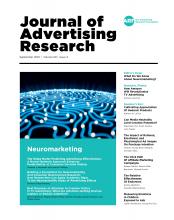ABSTRACT
Since its modern inception about two decades ago, the use of neuroscience tools and insights in studying advertising has grown an increasing prominence in the researcher's toolbox. As a branch of applied neuroscience, labels such as “neuromarketing” and “consumer neuroscience” often are used interchangeably, and this emerging field suffers from many inconsistencies. Methodological differences, conceptual inconsistencies, a lack of systematic validation of neuroscience-based metrics, and questionable business practices are all symptoms of a discipline that is in need of rigor and maturation. The goal of this article is to suggest a basic foundation for the use of neuroscience and related methods in studying advertising effects. Three main elements are suggested: a distinction among basic, translational, and applied research; a conceptual clarification; and a framework for the validation of neuroscience-based metrics.
- Received July 30, 2018.
- Received (in revised form) December 28, 2018.
- Accepted May 27, 2018.
- Copyright© 2019 ARF. All rights reserved.
ARF MEMBERS
If you are a member of the Advertising Research Foundation, you can access the content by logging in here
Log In
Pay Per Article - You may access this article (from the computer you are currently using) for 30 days for US$20.00
Regain Access - You can regain access to a recent Pay per Article purchase if your access period has not yet expired.





